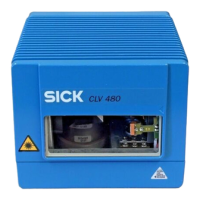Operating Instructions
CLV 480 Bar Code Scanner
8 010 080/O824/10-02-2005 © SICK AG · Division Auto Ident · Germany · All rights reserved I-13
Figures
Fig. 2-1: Laser warning labels on the CLV.....................................................................................2-3
Fig. 3-1: Design of the CLV 480 .......................................................................................................3-5
Fig. 3-2: Block diagram: CLV functions...........................................................................................3-6
Fig. 3-3: Dynamic focus control: classification of the reading range in distance
configurations.........................................................................................................................3-7
Fig. 3-4: CLV in stand-alone configuration (start/stop mode) and in tracking mode ...3-8
Fig. 3-5: LEDs........................................................................................................................................3-10
Fig. 4-1: Line scanner: replacing the laser warning labels......................................................4-2
Fig. 4-2: Line scanner: position of the securing threads on the CLV..................................4-3
Fig. 4-3: Line scanner: Mounting possibilities of the CLV........................................................4-3
Fig. 4-4: Scanning methods: alignment with bar code and conveyor direction..............4-4
Fig. 4-5: Definition of the reading distance a and of the aperture angle a ......................4-4
Fig. 4-6: Line scanner: Reading angle between the scan line and the bar code...........4-5
Fig. 4-7: Avoiding surface reflections: Angle between the emitted light and the
bar code (tilted away from the vertical axis) ..............................................................4-5
Fig. 4-8: Count direction of the code position CP in the scan line and of the
code angle CW for the oscillating mirror ......................................................................4-6
Fig. 4-9: Line scanner: scan line in Adjusting mode..................................................................4-9
Fig. 4-10: Line scanner: mounting example for the external reading pulse sensor.....4-10
Fig. 4-11: Mounting example for object distance detection..................................................4-12
Fig. 5-1: Block diagram: Connection of the CLV to the AMV/S 60
connection module...............................................................................................................5-3
Fig. 5-2: Connecting the host interface.......................................................................................5-15
Fig. 5-3: Connecting the terminal interface ...............................................................................5-16
Fig. 5-4: Connections of the "Sensor" switching input..........................................................5-17
Fig. 5-5: Connections of the "IN 0" to "IN 4" switching inputs ..........................................5-18
Fig. 5-6: Connections of the "Result 1" to "Result 4" switching outputs.......................5-21
Fig. 6-1: Bar code pattern (Code 39; module width 0.35 mm (13.8 mil);
Print ratio 2:1) ........................................................................................................................6-3
Fig. 6-2: Oscillating mirror: "Oscillating with fixed amplitude" mode ................................6-11
Fig. 6-3: Oscillating mirror: "Oscillating with variable amplitude" mode..........................6-12
Fig. 6-4: One-Shot: Object tracking (bar code read from front).........................................6-13
Fig. 6-5: CLV-Setup: Displaying the reading result in the Terminal Emulator ...............6-26
Fig. 6-6: Reading result of the terminal interface: structure for Good Read.................6-27
Fig. 6-7: Reading result of the terminal interface: structure for No Read......................6-27
Fig. 6-8: CLV-Setup: Displaying the percentage evaluation in the
Terminal Emulator..............................................................................................................6-29
Fig. 6-9: Appearance of scan line in the "Show CP-limits" mode .....................................6-31
Fig. 6-10: CLV-Setup: Selection of the signals to be displayed in I/O Monitoring.........6-32
Fig. 6-11: CLV-Setup: Example of output in the "I/O Monitoring" dialog box..................6-33
Fig. 6-12: CLV-Setup: "Operating Data" dialog box...................................................................6-36
Fig. 6-13: CLV-Setup: Displaying the reading result of the host interface in
the Terminal Emulator with direction identifier at the beginning
(in this case: O = Output)................................................................................................6-38
Fig. 6-14: CLV-Setup: Displaying the self-test result in the Terminal Emulator ..............6-40
Fig. 6-15: CLV-Setup: Dialog box for executing Show limits ..................................................6-41
Fig. 6-16: CLV-Setup: Displaying the system messages in the Terminal
Emulator when starting the CLV...................................................................................6-42
Fig. 7-1: Cleaning the reading window............................................................................................7-1
Fig. 7-2: Cleaning the external optical sensors (reading pulse generator,
object-height detector) .......................................................................................................7-2
Fig. 9-1: Dimensions of the CLV 480 line scanner, front reading window .......................9-3
Fig. 9-2: Dimensions of the CLV 480: line scanner with oscillating mirror,
side reading window ............................................................................................................9-4
Fig. 10-1: CLV 480-0010/-0011 (line scanner): Reading field height as a
function of the reading distance and resolution ....................................................10-3

